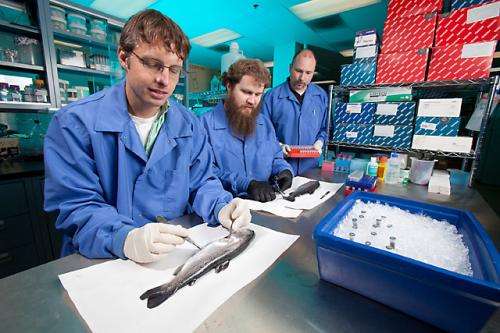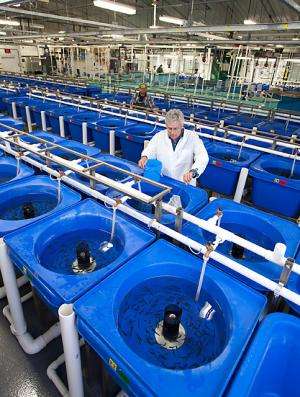Detecting and preventing disease in trout

Each year, the rainbow trout industry suffers significant economic losses due to bacterial cold-water disease, caused by the bacterium Flavobacterium psychrophilum. The disease also affects salmon and other cold-water fish species. It first occurs when fish are small, often leading to rapid death. Larger fish can become chronically infected and consequently have lesions and impaired growth and yield.
At the Agricultural Research Service's National Center for Cool and Cold Water Aquaculture (NCCCWA) in Leetown, West Virginia, scientists have developed a new line of trout that is resistant to bacterial cold-water disease. They've also developed a susceptible line and a control line to use in studies of how breeding changes disease-resistance properties in trout. They have identified regions on several chromosomes that are responsible for disease resistance and have developed a test that detects F. psychrophilum after infection.
Molecular biologist Greg Wiens and geneticist Timothy Leeds recently completed a field performance evaluation in collaboration with industry and government stakeholders. In a study that appeared in Aquaculture in 2013, Wiens measured performance of the control, susceptible, and disease-resistant lines of fish under farm conditions before and after natural exposure to the pathogen.
"After exposure, the disease-resistant line had a higher rate of survival than the control or susceptible lines," Wiens says. "In addition, during the outbreak, fewer disease-resistant fish harbored the pathogen in their internal tissues, compared to the control and susceptible fish."

Wiens and postdoctoral fellow David Marancik developed a highly sensitive real-time polymerase chain reaction test that accurately measures small amounts of F. psychrophilum in fish tissue. The test recognizes a unique gene sequence that is only found in that pathogen. In the study, published in FEMS Microbiology Letters in 2013, more than 200 different isolates of F. psychrophilum were detected. These isolates were all collected at farms where fish suffered from the disease.
"No other species of environmental bacteria or fish pathogens were recognized by the test, which demonstrates its high specificity," Wiens says. At the conclusion of the farm trial, the test confirmed that the resistant-line fish did not harbor detectable levels of pathogen.
Scientists at NCCCWA are also investigating mechanisms that cause fish to be disease resistant. After finding a correlation between disease resistance and larger spleen size in rainbow trout, Wiens and geneticist Yniv Palti searched for common genetic regions that influence both spleen size and disease resistance.
In their study, published in PLOS ONE in 2013, they mapped regions in the trout genome that determine spleen size and found links to chromosomes 19, 16, and 5. They also mapped disease resistance and found a closely linked region on chromosome 19 that had a major effect on bacterial cold-water disease resistance.
"This is the first study to identify a genetic link between a physical trait—spleen size—and specific disease resistance in fish," Wiens says. "We are now working to identify genes and mechanisms of resistance."
Based on the results of several field trials and laboratory-evaluation data, disease-resistant rainbow trout germplasm was released in 2012 and 2013 to stakeholders, who are propagating the line and continuing to evaluate its performance in large-scale trials in conjunction with NCCCWA scientists.
Journal information: PLoS ONE
Provided by Agricultural Research Service















